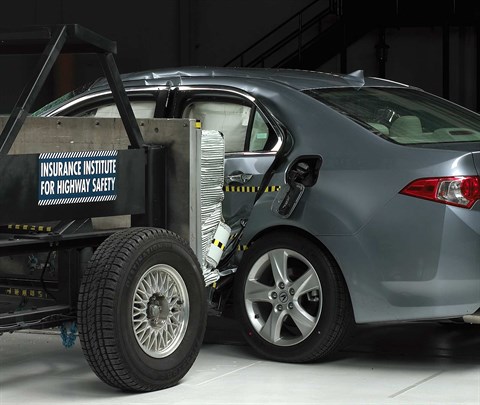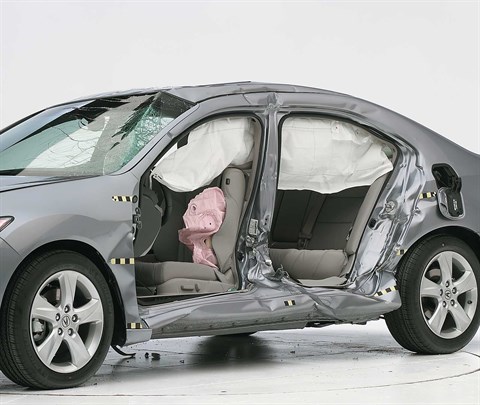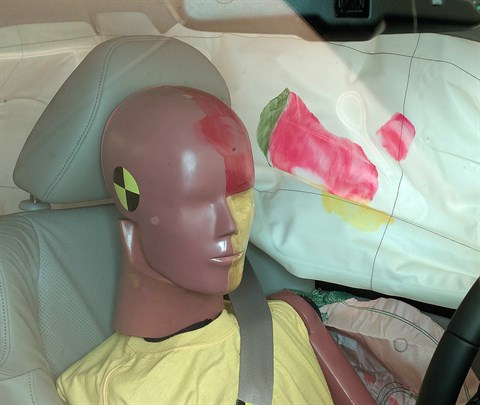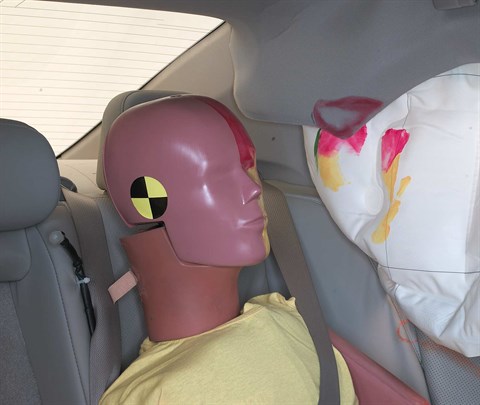Small overlap front: driver-side
Rating applies to 2009-14 models
Tested vehicle: 2012 Acura TSX 4-door
The Acura TSX was redesigned for the 2009 model year. The small overlap front test ratings also apply to the station wagon version of the TSX, known as the TSX Sport Wagon, beginning with 2011 models.
Two tests of the TSX were conducted because the onboard (car interior) cameras failed during the first test. Also in the first test, the driver side curtain and side thorax airbags deployed, but they did not in the second test. Honda subsequently provided data showing that the side airbags are close to their deployment threshold under the small overlap test conditions. The restraints and dummy kinematics rating is based on the second test. Injury and structural ratings are based on both tests.
| Evaluation criteria | Rating |
|---|---|
| Structure and safety cage | |
| Driver injury measures | |
| Head/neck | |
| Chest | |
| Hip/thigh | |
| Lower leg/foot | |
| Driver restraints and dummy kinematics In the second test, the dummy’s head contacted the frontal airbag but slid off the left side, leaving the head vulnerable to contact with forward side structure. The side curtain airbag did not deploy, also leaving the dummy’s head vulnerable to contact with side structure and outside objects. | |

Action shot taken during the second of two small overlap frontal crash tests.

The dummy's position in relation to the door frame, steering wheel, and instrument panel indicates that the driver's survival space was not maintained well (second test without side airbag deployment).

In the second test, the dummy’s head contacted the frontal airbag but then slid off the left side as the steering column moved to the right. The side curtain airbag did not deploy.

Intrusion by the door hinge pillar and instrument panel contributed to a high risk of injury to the dummy's left lower leg.
Moderate overlap front: original test
Rating applies to 2009-14 models
Tested vehicle: 2009 Acura TSX 4-door
The Acura TSX was redesigned for the 2009 model year. Frontal ratings are assigned by the Institute based on a test conducted by Honda.
The frontal crash test ratings also apply to the station wagon version of the TSX, known as the TSX Sport Wagon, beginning with 2011 models.
| Evaluation criteria | Rating |
|---|---|
| Overall evaluation | |
| Structure and safety cage | |
| Driver injury measures | |
| Head/neck | |
| Chest | |
| Leg/foot, left | |
| Leg/foot, right | |
| Driver restraints and dummy kinematics | |
Side: original test
Rating applies to 2009-14 models
Tested vehicle: 2009 Acura TSX 4-door with standard front and rear head curtain airbags and standard front seat-mounted side torso airbags
The Acura TSX was redesigned for the 2009 model year. The side impact crash test ratings also apply to the station wagon version of the TSX, known as the TSX Sport Wagon, beginning with 2011 models.
| Evaluation criteria | Rating |
|---|---|
| Overall evaluation | |
| Structure and safety cage | |
| Driver injury measures | |
| Head/neck | |
| Torso | |
| Pelvis/leg | |
| Driver head protection | |
| Rear passenger injury measures | |
| Head/neck | |
| Torso | |
| Pelvis/leg | |
| Rear passenger head protection | |

View of the vehicle and barrier just after the crash test.

View of the vehicle after the crash with doors removed, showing the side airbags and damage to the occupant compartment.

Smeared greasepaint shows where the driver dummy's head was protected from being hit by hard structures by the side curtain airbag.

Smeared greasepaint shows where the rear passenger dummy’s head was protected by the side airbag.
Head restraints & seats
Seat type: Power leather seats with manual adjustable lumbar AHR
| Overall evaluation | |
|---|---|
| Dynamic rating | |
| Seat/head restraint geometry |
About the head restraint & seat test
Currently, IIHS tests apply only to front seats.
